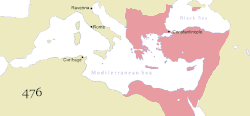
Back انحدار الإمبراطورية البيزنطية Arabic Declivi de l'Imperi Romà d'Orient Catalan Παρακμή της Βυζαντινής Αυτοκρατορίας Greek Decadencia bizantina Spanish Upadek Cesarstwa Bizantyńskiego Polish Bizans İmparatorluğu'nun gerilemesi Turkish 拜占庭帝國的衰落 Chinese
| History of the Byzantine Empire |
|---|
 |
| Preceding |
| Early period (330–717) |
| Middle period (717–1204) |
| Late period (1204–1453) |
| Timeline |
| By topic |
|
|
The Byzantine Empire experienced cycles of growth and decay over the course of nearly a thousand years, including major losses during the early Muslim conquests of the 7th century.
In the 11th century the empire experienced a major catastrophe in which most of its distant territories in Anatolia were lost to the Seljuks following the Battle of Manzikert and ensuing civil war. At the same time, the empire lost its last territory in Italy to the Norman Kingdom of Sicily and faced repeated attacks on its territory in the Balkans. These events created the context for Emperor Alexios I Komnenos to call to the West for help, which led to the First Crusade. However, economic concessions to the Italian Republics of Venice and Genoa weakened the empire's control over its own finances, especially from the 13th century onward, while tensions with the West led to the Sack of Constantinople by the forces of the Fourth Crusade in 1204 and the dismemberment of the empire.
Although a number of small Byzantine successor states survived, one of which eventually reclaimed Constantinople in 1261, the empire had been severely weakened. The Byzantines had withdrawn to Bithynia relocating their capital to Nicaea (present-day Iznik) during the Fourth Crusade. It would be nearly 60 years before they returned to the capital, leaving Bithynia weak and vulnerable. The early history of the eventual rise of Ottoman power remains shrouded in obscurity. One Byzantine chronicle refers to a skirmish between "Othman" and Byzantine forces in 1302 in the Marmara region near present day Yalova. What historians can agree on is that by the early 1330s Ottomans had taken Byzantine towns in Prusa (Bursa), Nicaea (Iznik) and Nicomedia (Izmit).
Constantinople was left isolated as the Islamic empire gained a foothold in the Balkans under the leadership of Orhan Gazi and his son Murad I. They rapidly conquered the Byzantine heartland over the course of the 14th century leading to the Fall of Trebizond and the Fall of Constantinople by the army of Sultan Mehmed the Conqueror in the 15th century. While internal struggles continued between the Ottomans and other Turkish rulers in Anatolia, with the fall of Trebizond the last truly Byzantine outpost in Anatolia was lost.[1] While conflict continued between the Ottomans and other Muslims in Anatolia, the Ottomans mostly ignored them to focus on westward expansion into the Christian lands of southeastern Europe.
- ^ Lowry, Heath. "Early Ottoman Period". In Heper, Metin; Sayari, Sabri (eds.). The Routledge Handbook of Modern Turkey. Routledge.
© MMXXIII Rich X Search. We shall prevail. All rights reserved. Rich X Search